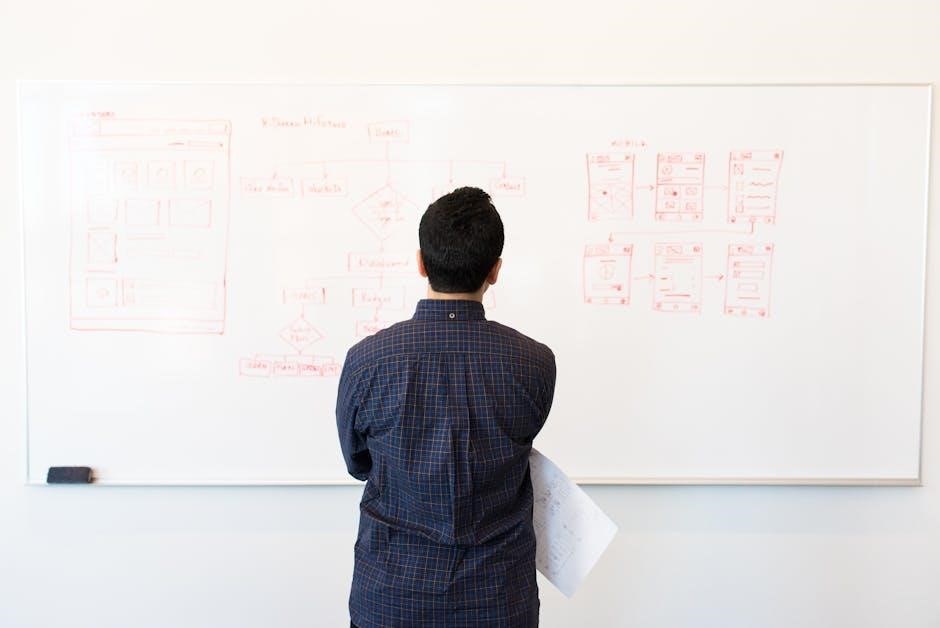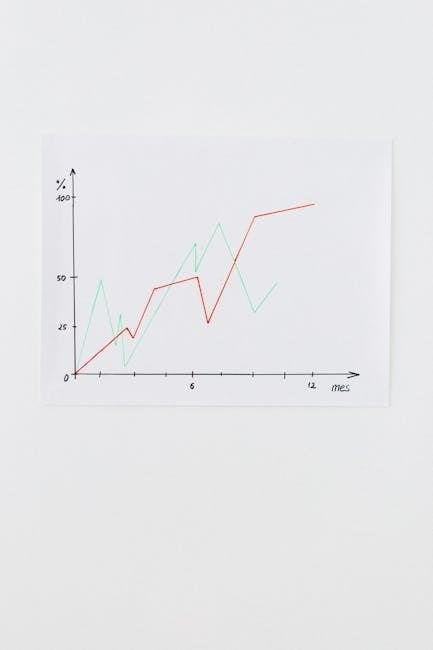The 42-inch Husqvarna belt replacement diagram provides a visual guide for installing and routing the deck belt, ensuring optimal mower performance and longevity․ This PDF is essential for homeowners and professionals to maintain their Husqvarna lawn mower efficiently․
1․1 Importance of Belt Replacement for Optimal Performance
Regular belt replacement is crucial for maintaining the optimal performance and efficiency of your 42-inch Husqvarna mower․ A worn or damaged belt can lead to uneven cutting, reduced mower efficiency, and potential damage to the deck or engine․ Replacing the belt ensures smooth operation, consistent cutting results, and extends the lifespan of the mower․ Proper belt installation, guided by a detailed diagram, prevents misalignment and ensures the mower operates at its best, reducing the risk of costly repairs and downtime․
1․2 Overview of the 42-Inch Husqvarna Mower Deck
The 42-inch Husqvarna mower deck is a durable and versatile cutting system designed for efficient lawn maintenance․ It features a reinforced structure and is compatible with various Husqvarna tractor models, including the YTH18542․ The deck incorporates pulleys, idlers, and a belt system that work together to power the mower blades․ A detailed belt replacement diagram is essential for understanding the deck’s components and ensuring proper belt installation and tensioning, which are critical for maintaining optimal performance and longevity․
1․3 Purpose of a Belt Replacement Diagram
A belt replacement diagram for a 42-inch Husqvarna mower deck serves as a visual guide, simplifying the replacement process․ It provides clear instructions on belt routing, pulley alignment, and tensioning, ensuring correct installation․ The diagram helps diagnose issues, confirms belt size, and prevents misalignment, which can lead to uneven cutting or premature wear․ By following the diagram, users can achieve proper belt installation, maintain optimal mower performance, and extend the lifespan of both the belt and deck components, ensuring efficient and effective lawn maintenance․

Understanding the Husqvarna 42-Inch Deck Belt
The 42-inch Husqvarna deck belt is a critical component, connecting the engine to the cutting deck․ It powers the mower’s blades and ensures smooth operation, requiring proper maintenance and alignment for optimal performance․
2․1 Key Components of the Deck Belt System
The deck belt system includes the drive belt, pulleys, idlers, and tensioners․ The drive belt powers the mower deck, while pulleys and idlers guide it․ Tensioners maintain proper belt tightness, preventing slippage․ These components work together to ensure efficient operation and even cutting․ Proper alignment and tension are crucial for longevity and performance․ The belt diagram helps identify each part, ensuring correct installation and functionality․ Regular inspection of these components prevents premature wear and maintains optimal mower efficiency․
2․2 The Role of the Belt in Mower Operation
The belt is essential for transferring power from the engine to the mower deck, enabling the cutting blades to rotate․ It ensures consistent blade speed, maintaining cut quality․ Proper belt tension and alignment are critical for smooth operation, preventing slippage and uneven cutting․ The belt’s role is vital for efficient mowing performance, and its condition directly impacts the mower’s overall functionality․ Regular inspections and timely replacements, guided by the diagram, help sustain optimal operation and extend the mower’s lifespan․
2․3 Signs Indicating the Need for Belt Replacement
Signs indicating the need for belt replacement include visible wear, cracks, or frays on the belt․ Noise, vibration, or slippage during operation are also key indicators․ If the belt slips off pulleys or causes uneven cutting, replacement is necessary․ Regular inspections, as outlined in the diagram, help identify these issues early․ Ignoring these signs can lead to poor cut quality and reduced mower performance․ Consulting the diagram ensures proper identification and replacement steps for maintaining optimal function․

Safety Precautions and Tools Needed
Always turn off the mower and let it cool before starting․ Wear gloves and protective eyewear․ Gather tools like a socket wrench and pliers․ Ensure loose clothing is secured and work in a safe, well-lit area to prevent accidents during belt replacement․
3․1 Essential Safety Gear and Precautions
Always wear gloves and protective eyewear when working on your mower․ Turn off the engine and let it cool to avoid burns․ Ensure the mower is on a level surface with the parking brake engaged․ Secure loose clothing and tie back long hair to prevent entanglement․ Keep children and pets away from the work area․ Use jack stands for stability if lifting the mower․ Avoid working in hazardous conditions, and ensure proper lighting for visibility․ Never work under an unsupported deck or with loose parts․
3․2 Tools Required for Belt Replacement
To replace the belt on your 42-inch Husqvarna mower, gather essential tools: a socket wrench, pliers, a screwdriver, and a torque wrench․ The socket wrench is used to loosen pulley guards and tensioners, while pliers help remove the belt from idlers․ A screwdriver may be needed to remove deck guards․ A torque wrench ensures proper tensioning․ Additionally, refer to the belt replacement diagram for specific guidance on tool usage and component locations․ Having all tools ready ensures a smooth and efficient replacement process without delays․

Preparing for Belt Replacement
Gather tools and materials, ensure the mower is turned off, and let the engine cool․ Consult the diagram to understand the belt’s routing and components․ Prepare safely․
4․1 Gathering Necessary Tools and Materials
To begin the belt replacement process, gather essential tools and materials․ These include a socket wrench, pliers, a torque wrench, gloves, safety glasses, and a new belt․ Ensure you have the correct belt size as specified in the diagram․ Additional materials like a flat tool for prying and a silicone-based lubricant for pulleys may also be useful․ Refer to the Husqvarna 42-inch belt replacement diagram to confirm the required tools and materials, ensuring you are fully prepared for the task․ Proper preparation is key to a smooth and successful replacement process․
4․2 Locating the Deck Belt on the Husqvarna Mower
Locate the deck belt on your Husqvarna mower by examining the mower deck, typically found near the pulleys and idlers․ The belt wraps around the engine pulley, deck pulleys, and idlers, maintaining proper tension․ Use the diagram to trace its route, ensuring alignment with all components․ Familiarize yourself with the belt’s path to avoid misalignment during replacement․ Understanding its placement is crucial for accurate reinstallation and optimal mower performance․ Refer to the diagram for specific locations and visual guidance to ensure clarity and precision in identifying the belt’s position․
4․3 Accessing the Deck Belt and Pulleys
To access the deck belt and pulleys, begin by turning off the mower and allowing the engine to cool․ Remove the deck belt guards or covers using a socket wrench or appropriate tools․ For most 42-inch Husqvarna models, this involves loosening bolts or clips․ Gently pull the cover away to expose the belt and pulleys․ Refer to the diagram for specific locations of bolts and latches․ Wear protective gloves to avoid sharp edges or debris․ This step ensures safe and clear access for belt inspection or replacement, aligning with the diagram’s guidance for precise handling․
4․4 Disconnecting the Old Belt
To disconnect the old belt, start by loosening the tensioner using a socket wrench․ Carefully pull the belt off the pulleys, working from one side to the other․ Remove any remaining fragments or debris․ If the belt is stuck, gently pry it off with a flat tool․ Wear gloves to protect your hands from sharp edges or friction․ Refer to the diagram for pulley locations and proper removal techniques․ This step ensures the old belt is safely and completely removed, preparing the mower for the new belt installation․

Removing the Old Belt
Remove the belt cover and carefully disengage the belt from pulleys and idlers․ Use tools to release tension and slide the belt off, referencing the diagram for specific locations and steps to avoid damage or misalignment during removal․ This ensures the old belt is safely and completely removed, preparing the mower for the new belt installation․ The diagram assists in avoiding damage or misalignment, ensuring a smooth process․
5․1 Steps to Remove the Belt Cover
To remove the belt cover, start by turning off the mower and allowing the engine to cool․ Use a socket wrench to loosen the bolts or clips securing the cover․ Gently pull the cover away to expose the belt and pulleys․ For most 42-inch Husqvarna models, this involves loosening bolts or clips․ Wear protective gloves to avoid sharp edges, and refer to the diagram for specific bolt locations․ Once removed, you’ll have clear access to inspect and remove the old belt, ensuring a smooth replacement process․ Always follow safety precautions and the diagram for guidance․
5․2 Disconnecting the Belt from Pulleys and Idlers
Disconnect the belt by loosening the tensioner using a socket wrench․ Carefully pull the belt off the pulleys, working from one side to the other․ Remove any remaining fragments or debris․ If the belt is stuck, gently pry it off with a flat tool․ Wear gloves to protect your hands from sharp edges or friction․ Refer to the diagram for pulley locations and proper removal techniques․ This step ensures the old belt is completely removed, preparing for the new belt installation․ Proper handling prevents damage to the mower’s components․
5․3 Completely Removing the Old Belt
After disconnecting the belt, slide it off the pulleys and idlers․ Remove any remaining fragments or debris from the system․ Inspect the area to ensure no parts of the old belt are left behind․ Use gloves to protect your hands from sharp edges․ Refer to the diagram for specific locations of pulleys and idlers․ Completely removing the old belt ensures a clean and accurate installation of the new one․ This step is crucial for maintaining the mower’s performance and preventing future issues with the new belt․ Proper removal sets the stage for a successful replacement process․
Installing the New Belt
Install the new belt by aligning it with the pulleys, ensuring correct routing as shown in the diagram․ Thread it through idlers and tension properly for smooth operation․
6․1 Aligning the New Belt with Pulleys
Align the new belt with the pulleys by following the diagram’s routing guide․ Start with the center spindle pulley, ensuring the belt matches the diagram’s path․ Check for twists and proper seating on all pulleys and idlers․ Use the diagram to confirm correct alignment, as misalignment can cause noise or vibration․ Ensure the belt is snug but not overly tight, and verify its position against the diagram before proceeding with installation․
6․2 Threading the Belt Through Idlers and Pulleys
Start by threading the new belt around the center spindle pulley, ensuring it aligns with the diagram’s routing․ Gently guide the belt through each idler and pulley, avoiding twists․ Use the diagram to verify the correct path․ After threading, check the belt’s tension by pressing firmly—it should have minimal give․ Adjust the tensioner if necessary to ensure smooth operation․ Proper threading ensures the belt operates efficiently without premature wear․
6․3 Ensuring Proper Belt Tension
Proper belt tension is critical for smooth operation․ Use a socket wrench to tighten the idler pulley, ensuring the belt is snug but not overly tight․ Refer to the diagram for correct tensioning points․ Check the belt’s tension by pressing firmly—it should have minimal give․ Proper tension prevents slippage and wear․ Once tightened, test the mower to ensure smooth operation and adjust if necessary for optimal performance․ Correct tension ensures efficient mowing and extends the belt’s lifespan․
Post-Installation Checks
After installing the new belt, reattach deck guards and test the mower for smooth operation․ Ensure the belt runs quietly and all components are clear of obstructions․
7․1 Reattaching Deck Guards and Components
After installing the new belt, reattach all deck guards and components securely․ Refer to the diagram to ensure correct alignment and positioning․ Tighten all bolts firmly to maintain stability and prevent vibration․ Double-check that the belt is properly seated on all pulleys and idlers․ Finally, verify that all components are clear of obstructions before proceeding to test the mower․ Proper reassembly ensures safe and efficient operation, preventing potential damage or performance issues․
7․2 Testing the Mower for Smooth Operation
Start the mower and listen for unusual noises or vibrations․ Ensure the belt operates smoothly without slipping․ Test the mower at varying speeds to confirm proper functionality․ Check if the cutting deck engages and disengages correctly․ Perform a test drive to verify even cutting and belt alignment․ Address any issues promptly to prevent further damage or performance loss․ Proper testing ensures the mower runs efficiently and maintains optimal cut quality, confirming a successful belt replacement process․

Common Mistakes to Avoid
Common mistakes include incorrect belt tension, misalignment, and ignoring pre-installation checks․ These errors can lead to uneven cutting, reduced belt lifespan, or mower performance issues․
8․1 Incorrect Belt Tension and Alignment
Incorrect belt tension and alignment are common issues that can lead to poor performance․ Over-tightening may cause excessive wear, while under-tightening can result in slippage․ Misalignment can cause uneven cutting and noise․ Always refer to the diagram to ensure the belt follows the correct path around pulleys and idlers․ Proper tension ensures smooth operation and prevents premature wear․ Testing post-installation is crucial to confirm correct alignment and tension․ Addressing these issues promptly ensures optimal mower performance and extends the belt’s lifespan․
8․2 Ignoring Pre-Installation Checks
Ignoring pre-installation checks can lead to improper belt installation․ Failing to inspect pulleys, idlers, and deck components may result in misalignment or uneven wear․ Always clean debris and ensure all parts are in good condition before installing the new belt․ Skipping these steps can cause the belt to slip or wear out faster, leading to decreased mower performance and potentially damaging other components․ Consistency is key for optimal results and ensures the longevity of both the belt and the mower deck․

Troubleshooting Belt Issues
Troubleshooting belt issues involves diagnosing wear, noise, or slippage․ Misalignment or improper tension are common causes․ Always refer to the diagram for proper belt installation and adjustment․
9․1 Diagnosing Belt Wear or Misalignment
Diagnosing belt wear or misalignment involves inspecting for cracks, frays, or uneven wear․ Use the belt diagram to ensure proper alignment and seating on pulleys and idlers․ Misalignment can cause uneven cutting or noise․ Refer to the PDF diagram for correct routing and specifications․ Regular inspections after every 50 hours of use help detect issues early, preventing further damage․ Proper alignment and tensioning are crucial for smooth operation and extending belt life․
9․2 Addressing Noisy or Slipping Belts
Noisy or slipping belts indicate potential issues with tension or alignment․ Check if the belt is properly seated on pulleys using the diagram․ If slipping occurs, tighten the tensioner․ Noise may stem from misalignment or worn pulleys․ Lubricate idlers and pulleys with silicone-based spray or grease, and ensure the belt path matches the PDF guide․ Correcting these issues prevents further damage and ensures efficient mower operation․ Regular inspections and adjustments are key to maintaining smooth performance and extending belt lifespan․

Maintenance Tips for Extended Belt Life
Regularly inspect the belt for wear, clean debris, and lubricate pulleys․ Proper alignment and tensioning, as per the diagram, ensure smooth operation and extend belt longevity․
10․1 Regular Inspections for Wear and Tear
Regular inspections are crucial for detecting wear and tear on the 42-inch Husqvarna belt․ Check for cracks, frays, or uneven wear, and ensure proper alignment․ Refer to the diagram for correct routing․ Clean debris from pulleys and idlers to prevent damage․ Inspect the belt after every 50 hours of use to maintain optimal performance and longevity․ Early detection of issues prevents unexpected breakdowns and ensures smooth mower operation․
10․2 Lubricating Pulleys and Idlers
Lubricating pulleys and idlers is essential for smooth operation and extending the belt’s lifespan․ Use a silicone-based spray or grease on moving parts after cleaning․ Apply lubricant to prevent friction and wear․ Refer to the diagram for correct locations․ Regular lubrication ensures efficient mowing performance and reduces the risk of premature belt wear․ This maintenance step, combined with inspections, keeps the 42-inch Husqvarna mower running at its best․

Model-Specific Considerations
The Husqvarna YTH18542 and other 42-inch models may have unique belt routing and deck designs․ Always consult the specific diagram for accurate installation and performance․
11․1 Husqvarna YTH18542 Belt Replacement
The Husqvarna YTH18542 requires precise belt replacement steps․ Start by removing the deck and disconnecting the electric clutch․ Use a socket wrench to loosen pulley guards․ Refer to the diagram for accurate routing․ Ensure the belt aligns with pulleys and idlers, maintaining proper tension․ The YTH18542’s specific belt size and routing make it crucial to follow the diagram closely․ After installation, test the mower to confirm smooth operation and even cutting․ Proper replacement ensures optimal performance and prevents common issues specific to this model․
11․2 Variations in Other 42-Inch Husqvarna Models
Other 42-inch Husqvarna models, like the RZ5424, may have unique pulley setups requiring specific diagrams․ The YTH18542 differs with its electric clutch, while others use manual clutches․ Always consult the exact model’s diagram for precise belt routing and tensioning․ Variations in pulley placement and mechanisms can affect performance and belt longevity․ Correct installation ensures optimal results, so refer to the specific guide for your model to avoid common pitfalls and maintain efficiency․

Safety Reminders Throughout the Process
Always turn off the mower and let it cool before starting․ Wear gloves and safety glasses, and secure loose clothing․ Ensure a stable work environment and keep children away to prevent accidents․
12․1 Ensuring a Safe Working Environment
A safe working environment is crucial for successful belt replacement․ Always turn off the mower, allow it to cool, and ensure it’s on a level surface․ Wear protective gear like gloves and safety glasses․ Secure loose clothing and tie back long hair to avoid entanglement․ Keep children and pets away from the work area․ Proper lighting is essential for visibility, and avoid working in hazardous conditions․ Using jack stands for stability when lifting the mower prevents accidents and ensures a secure setup․
12․2 Proper Handling of Tools and Belts
Proper handling of tools and belts is essential for safety and efficiency․ Use wrenches and pliers carefully to avoid stripping bolts or damaging components․ Store belts in a dry, shaded area to prevent cracking․ Avoid stretching or forcing the belt during installation, as this can lead to premature wear․ Always refer to the diagram for correct routing and tensioning․ Keep tools organized and within reach to minimize misplacement․ Handle belts with care to prevent cuts or abrasions․ Proper handling ensures a smooth replacement process and maintains the integrity of your tools and mower components․
Replacing the 42-inch Husqvarna belt is straightforward with the diagram․ It ensures proper installation, extending belt life and mowing efficiency․ Follow safety guidelines and handle tools carefully for success․
13․1 Summary of Key Steps and Benefits
Replacing the 42-inch Husqvarna belt involves aligning the new belt with pulleys, threading it through idlers, and ensuring proper tension․ This process, guided by the diagram, prevents misalignment and wear․ Regular inspections, lubrication, and correct installation extend belt life and maintain mower efficiency․ Following safety precautions and using the right tools ensures a smooth, accident-free replacement․ The benefits include optimal performance, reduced wear, and extended lifespan of both the belt and mower deck components, making the process worthwhile for long-term reliability․
13․2 Final Tips for Successful Belt Replacement
Always refer to the diagram for accurate belt routing and tensioning․ Ensure proper alignment to prevent uneven wear and noise․ Test the mower post-installation to confirm smooth operation․ Clean debris from pulleys and idlers before installing the new belt․ Regular inspections and lubrication will extend the belt’s lifespan․ Store belts in a dry, cool place to prevent damage․ Follow these tips for a successful replacement and optimal mower performance․
